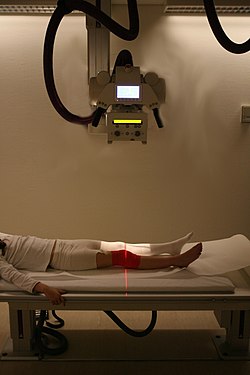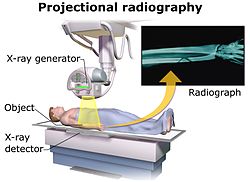Radiography
Radiography Media
Taking an X-ray image with early Crookes tube apparatus, late 1800s
1897 sciagraph (X-ray photograph) of Pelophylax lessonae (then Rana Esculenta), from James Green & James H. Gardiner's "Sciagraphs of British Batrachians and Reptiles"
Acquisition of projectional radiography, with an X-ray generator and a detector
Images generated from computed tomography, including a 3D rendered image at upper left
Angiogram showing a transverse projection of the vertebro basilar and posterior cerebral circulation
Radiography may also be used in paleontology, such as for these radiographs of the Darwinius fossil Ida.
A plain radiograph of the elbow
AP radiograph of the lumbar spine
 Radiography of the knee in a modern X-ray machine. |
Radiography is the name for the use of X-rays to see what is happening to parts of the body. It is an imaging technique which uses electromagnetic radiation other than light, usually X-rays.
To create the image, a beam of X-rays is produced by an X-ray machine and is projected toward the object. A certain amount of X-ray is absorbed by the object, which is dependent on the density and composition of that object. The X-rays that pass through the object are captured behind the object by a detector (either photographic film or a digital detector). The detector gives a superimposed 2D representation of the object's internal structures.
Tomography
Tomography is a more advanced way of using X-rays. In tomography, the machine blurs out structures not in the focal plane. This gives a series of pictures, like a set of slices through the body. It is called CT scanning, or computer tomography. The computer builds a 3-D picture for the expert to look at.
Radiography has many medical and industrial uses.








